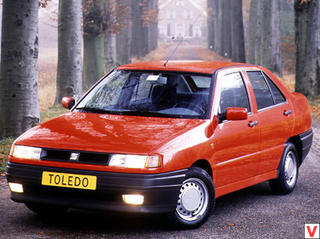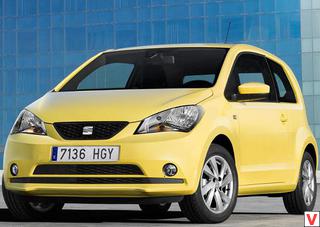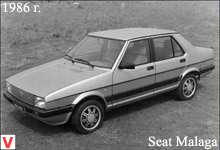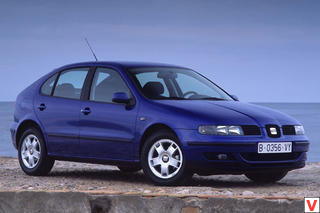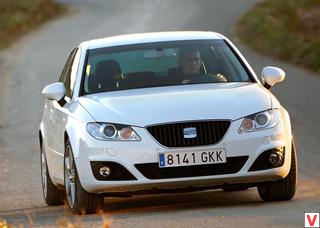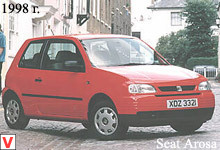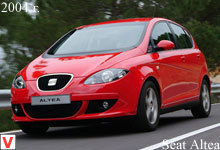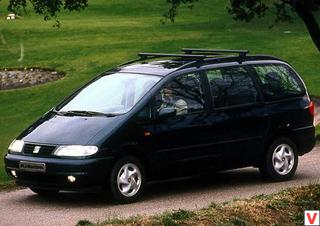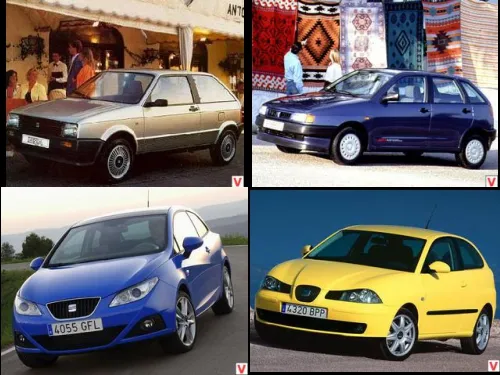
The first generation Seat Ibiza debuted in 1984. Angular, but fashionable at the time the car, the style of which was created by the famous Georgetto Giugiaro, became the very first private car Seat, and not a licensed copy of Fiat, as it was until then. But the car was designed in cooperation with the concern FIAT. As a result, many units were of Italian origin, in particular from the Fiat Uno and Ritmo models.
The design of the body and the interior was developed studio Ital Design. For the technical part (the modernization of the engine and the development of the suspension) were responsible specialists from Porsche. The first generation Ibiza was produced with a body of 3- and 5-door hatchback, was in demand not only in Spain itself, but also in neighboring countries. Ibiza even made it to the finals of the Car of the Year competition.
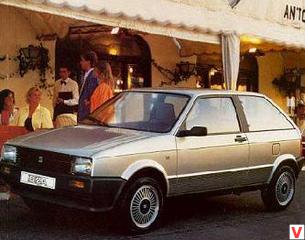
After Volkswagen’s acquisition of a controlling stake and rights to the Seat brand, a complete change of power units was carried out, a thorough restyling of the body and the interior. In May 1993, the second-generation Ibiza, built on the Volkswagen platform B platform, was introduced at the Barcelona Motor Show. The car was produced in the form of a three- and five-door hatchback, and the versions with a sedan and station wagon were allocated to a separate model line and were called respectively Cordoba and Cordoba Variant.
The exterior of Ibiza II was also created by Giugiaro. This small car could comfortably accommodate only the driver and passenger. Passengers who were behind, interfered with a low ceiling and the backs of the front seats. The successes of the second generation Ibiza saved the Seat from the financial collapse that befell the company. For Ibiza II was offered a wide range of VW engines. Ten petrol units, from the weakest volume of 1 liter and power of 45 horsepower to the most powerful 16-tiklapannogo two-liter capacity of 150 "horses".
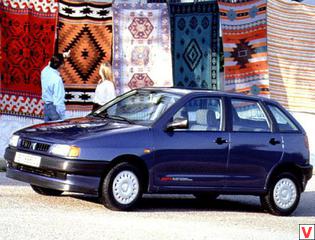
Diesel engines were six. One of them has a volume of 1.7 liters, power 60 hp, all others have a volume of 1.9 lira, power varies from 64 hp up to 110, there are two turbirovan among them. All engines are aggregated with 5-step mechanics. In 1999, Ibiza experienced a restyling. Despite the fact that the shape of the car remained the same, it is prettier. The grille, which has become more aggressive, the front and rear lighting, as well as a spoiler, underwent changes.
With the appearance in 2002 of the third generation, the sports image of Ibiza was strengthened even more thanks to the dynamic design from Walter de Silva (Walter de'Silva) and two sports modifications at once: FR and Cupra. Many reputable car publishers, including the British “What car?”, Have recognized the model as the best in class. The interior has changed the shape of the parts and their finishing. The rear seats have become more comfortable compared to the previous generation. The amount of luggage is small, but sufficient for a car of this class.
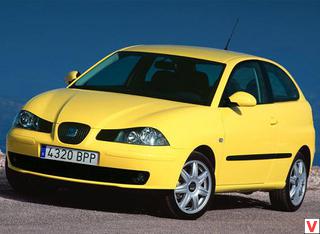
On Ibiza III installed five gasoline and four diesel units. Two petrol have a volume of 1.2 liters and have a capacity of 54 and 64 hp, two more petrol have a volume of 1.4 liters, both 16-tiklapannye, having a capacity of 75 and 100 "horses", the most powerful gasoline has a volume of 1.8 liters and a capacity of 150 liters .from. Diesel engines are represented by one 1.4-liter 75-horsepower and three 1.9-liter engines with a capacity of 68 to 130 horsepower, two of which are equipped with a turbine.
In April 2008, at the company's plant in Martorell (Martorell), the premiere of a new, already the fourth in a row, generation of the most important and most popular Spanish model, the compact hatchback Seat Ibiza, was held. Ibiza IV was the first model in the Volkswagen group, built on a new platform designed specifically for the supermini segment. This platform provides not only improved quality, but also a high level of vehicle safety. The expressive features of Seat Bocanegra’s Geneva “konzept” are clearly discernible in the slightly aggressive look of Ibiza IV, although they are significantly smoothed by technologists for the needs of mass production.

The bumper and grille lowered significantly below the surface of the hood, which allowed the car to give a revolutionary swept shape. This decision emphasized the “dynamic line” of the wings and completed the original sports image of the car. Expanding arches, mirrors located below the window line, and a spectacular front bumper air intake add to the car a distinct sporty look and youthful character.
Salon - sporty, stylish, high-quality. The dashboard is deployed to the driver. The deflectors brought to the forefront effectively provide air flow, creating comfort for passengers. In accordance with the latest trends, Ibiza has “grown up” in all dimensions, having crossed the four-meter mark in length (4.05 m vs. 3.97 m). The width and height also increased to 1.69 and 1.44 m, respectively, and an increased track (30 mm front and 33 mm rear) promises improved handling and stability in steep turns. The wheelbase has increased by 7 mm and is now 2,469 mm. The increase in size has a positive effect on the size of the cabin, as well as the capacity of the luggage compartment.
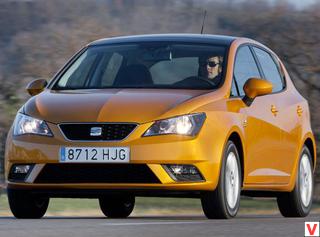
The increase in luggage capacity by 25 liters allows you to call Ibiza a leader in its segment with a useful boot volume of 292 liters. Under the hood, proven petrol engines with a volume of 1.2 liters (70 liters. Pp.), 1.4 liters (85 liters. Pp.) And 1.6 liters (105 liters. Pp.).
Diesel power units were also subjected to modernization, which allowed to increase the working range and increase torque. The 1.4-liter diesel engine retains 80 hp, while the 1.9 TDI engines have increased their power to 90 or 105 hp. The only transmission option is a five-speed “mechanics”.
In March 2012, a restyled version of the fourth generation Ibiza was presented at the Geneva Motor Show. The Belgian Luc Donkervolke, who had previously worked for Lamborghini, had a hand in developing the exterior. The most noticeable changes undergone the front of the car. Exterior has acquired a more aggressive design. First of all, another form of head optics catches the eye. In addition, the opportunity to order LEDs (both front and rear). The car has changed the grille, reshaped and bumper, changing its shape and increasing the number of sharp edges, and the new head optics acquired bi-xenon lamps and sections of LED lights.
Behind the changes were not so noticeable: a slightly different form of lamps and retouched bumper. As before, the 2013 Seat Ibiza model year is offered in three variants of the body - three-door SC (Sport Coupe), five-door hatchback and ST wagon (Sport Tourer). The manufacturer did not stint on the transformation in the cabin. So the dashboard has undergone some correction, however, data from the speedometer, tachometer, as well as the on-board computer are still readable.
Underlined austerity and severity is diluted by increasing the color options for interior design. The multimedia system, already available in the basic configuration, is noteworthy that it supports the connection of third-party devices. Changes have undergone and the steering wheel (he gave a sporty look) and climate control control interface. A useful change was the increase in the useful volume of the glove box to 10.7 liters. For comparison, in the dorestayling variant, this parameter was 4.7 liters.
The rear seats of the Sport Coupe fold in the 40:60 ratio, the minimum amount of luggage is 284 liters, the five-door hatchback has 8 liters more. As for the Seat Ibiza ST station wagon, here in standard mode 430 liters are available, and with the folded back row the volume will be 1164 liters. The base engine for the 2013 Ibiza was a modest 60-horsepower petrol unit with a volume of 1.2 liters. The range of gasoline engines is complemented by turbocharged engines of the TSI series: the first with the same volume has 105 hp, torque of 175 Nm and low fuel consumption (5.1 liters per 100 km), the second has a volume of 1.4 liters and a capacity of 150 liters .from.
and from a place paired with a new gearbox DSG is able to give 100 km / h in 8 seconds. The maximum speed for this option is 212 km / h. Diesels are represented by 1.2 and 2.0-liter TDI with a return of 75 and 143 hp, respectively. The latter implies a maximum acceleration of up to 210 km / h.
